Spending for spending’s sake
Simply throwing money at education is not the solution
- Friday, March 20, 2009
Many believe that increasing per-pupil spending will improve education in Nevada and that Nevada spending per student ranks only 43rd in the nation. These individuals further assume that our public schools' low achievement and ostensibly low spending must be linked. After all, goes the theory, more money would allow schools to hire better teachers, afford better supplies and offer students a more productive learning environment.
Senator Michael Schneider (D-Las Vegas) intends to introduce on Monday, March 23, Senate Bill 2, legislation that would require the state to increase K-12 education per-pupil funding to the national average. The bill provides no direction for how the money is to be spent—only that it gets spent. According to Schneider, increasing per-pupil funding will improve the quality of education.
Unfortunately, there is little to no evidence demonstrating this belief to be true. In fact, as Nevada System of Higher Education Chancellor Jim Rogers has pointed out, education in Nevada has decreased in quality since 1960. And that's despite an inflation-adjusted per-pupil increase in spending of 153 percent. And that figure excludes all the spending on teacher pensions, capital costs and public debt. The following chart comes from figures from the U.S. Department of Education.
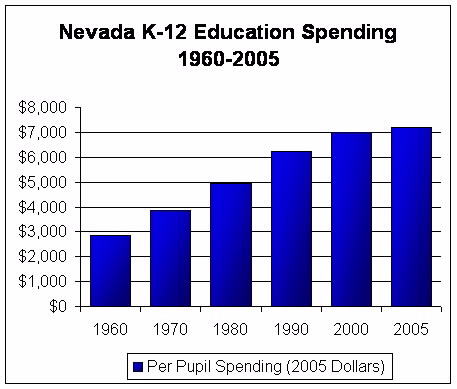
A quick regression analysis on the relationship between spending per pupil and student achievement on the National Assessment of Educational Progress (NAEP) fourth-grade reading exam reveals that increased funding accounts for just 7 percent of the variance in test results. Indeed, the likelihood is high that what relationship does exist between funding and student achievement occurs by chance. Both possibilities suggest there is no statistically significant relationship between spending and student achievement—a conclusion that many other researchers have reached many times over.
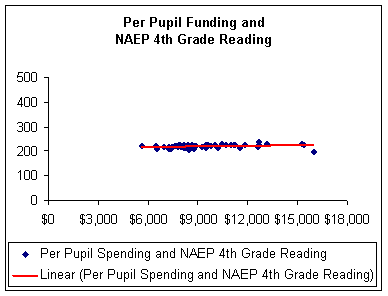
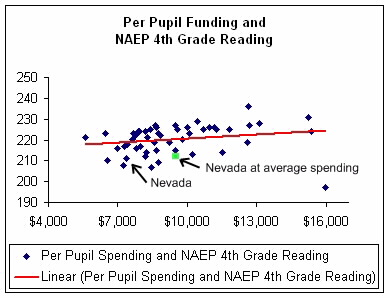
If a significant relationship existed between spending and educational achievement, the red line in the graph above would predict the trend in student achievement for each dollar spent. So, given that relationship, if Nevada's spending were increased to the average per-pupil amount, how much would fourth-grade NAEP reading scores in the state improve? The answer: approximately two points out of 500—still well below the national average.
In 2006, Nevada spent $7,345 per pupil, if capital costs, debt payments and teacher pensions are not counted. In terms of this particular accounting classification—known as "current spending"—the state ranked 43rd in the nation, according to the U.S. Census Bureau. In 2006, the national average was $9,332—a difference of $1,946. Thus, to reach the national average, Nevada would have to raise and spend an extra $835 million each year. This would be a 27 percent increase in general fund spending over the governor's proposed budget, and—since educational achievement has no positive correlation with higher spending—would waste $1.68 billion over the next biennium.
However, even before that, a problem arises with using the "average" per-pupil spending figures. The current spending per-pupil average is skewed upwards, thanks to Washington, D.C. ($15,970), New York ($15,338) and New Jersey ($15,244). Because of these and other very large outliers, we need to look at the median per-pupil figure to get a better understanding of what most states are spending. The median per-pupil spending is actually $8,672. So if we wanted to waste millions of dollars just to be like every other state, using the median "current spending per-pupil" figure saves us $285 million a year over what Schneider wants to waste.
But we can save much more. K-12 education in Nevada has a nasty habit of spending hordes of cash on new school construction and subsequent debt. When we add in those expenditures, Nevada's total spending per pupil was $9,738 in 2006 and is over $10,000 per pupil today.
Of that 2006 total, $1,842 was going to capital outlays—with $1,378 per pupil going to construction of new schools and $259 per pupil going to maintenance of existing schools. The remainder, $205, goes to equipment and training.
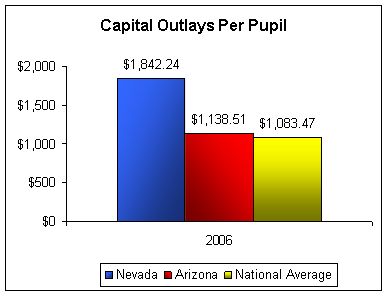
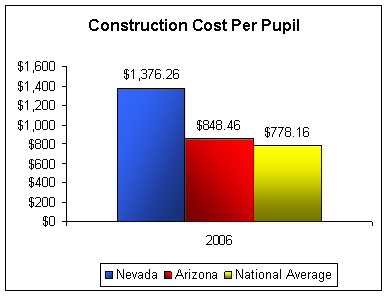
Nevada's capital outlay per pupil is the third-highest in the nation. While this has been blamed on the fact that the state has regularly been the fastest-growing state in the country, that's not the real reason. Arizona—often the second-fastest growing state, and now growing faster than Nevada—spends just $1,138 per pupil on capital outlays. If Nevada were as efficient as Arizona, we would save over $300 million in the next school year.
The second problem is that Nevada's K-12 education system is in debt up to its ears. The state's school debt-to-expenditure ratio ranks first in the country, at 121 percent of yearly expenditures. This means Nevada is paying large sums of money on interest, not on teaching students.
In fact, Nevada's education debt per student is nearly double the national average at $11,776 per student. Once again, growing faster than any other state in the country has little to nothing to do with this problem: Arizona's debt per student is $2,600 below the national average.

Nevada is simply providing a high-cost K-12 educational program that provides too much of its benefits to politically powerful special interest groups and provides little to no benefit to our students. On top of providing a below-average education to our children, we are saddling them with above-average debt. Essentially, we're making our children pay for the privilege of receiving a bad education that will leave them permanently disadvantaged.
If Nevada's policymakers are serious about improving the quality of education in this state, they will stop evading the power of real education reform. For examples of what to do, policymakers need to look no further than Florida. This is a state similar to Nevada demographically and in many other respects, but it is also a state that drastically improved the quality of education, despite such challenges. For more information on real education reform, see NPRI's new policy report, "Failure Is No Longer an Option."
Patrick R. Gibbons is an education policy analyst at the Nevada Policy Research Institute.





